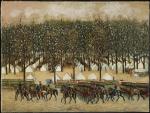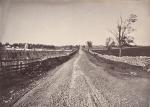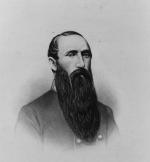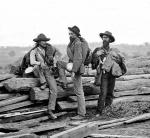Chapter 1: The Confederates Invade Pennsylvania
By the summer of 1863,the Civil War in the eastern theater was in a stalemate. After assuming command a year earlier, General Robert E. Lee and his smaller Army of Northern Virginia had repeatedly defeated the Union Army of the Potomac, first in the Seven Days' Campaign outside Richmond, Virginia, in June and July of 1862, then at Second Manassas in August. Lee then invaded Maryland, but was stopped in the bloody fighting at Antietam on September 17. At Fredericksburg on December 13 and yet again at the Battle of Chancellorsville (May 1-3, 1863), Lee's valiant soldiers repelled two more Union attacks. In spite of repeated victories, the larger Union army remained on Virginia soil, both defending Washington and threatening Richmond, the Confederate capital.
Two years of fighting in northern Virginia had devastated farming and food production in much of the region. After defeating the Yankees at Chancellorsville, Lee reorganized his army and decided to invade the North. By so doing, the general hoped to draw the Yankee army north across the Potomac and out of Virginia, thus giving some reprieve to Southern farmers.
In a highly successful three-day raid of south central Pennsylvania in October 1862, Confederate cavalry commander Jeb Stuart had returned south with more than 1,200 horses. Lee hoped to gather supplies (horses, cattle, fodder, and other related foodstuffs) to replenish his troops. He also hoped that a victory on Northern soil might help sway foreign recognition of the Confederacy and perhaps weaken the North's will to continue the war.
raid of south central Pennsylvania in October 1862, Confederate cavalry commander Jeb Stuart had returned south with more than 1,200 horses. Lee hoped to gather supplies (horses, cattle, fodder, and other related foodstuffs) to replenish his troops. He also hoped that a victory on Northern soil might help sway foreign recognition of the Confederacy and perhaps weaken the North's will to continue the war.
In early June, Lee's troops began moving northwest from Fredericksburg into the Shenandoah Valley. Once Lieutenant General Richard S. Ewell, commander of the Second Corps, Army of Northern Virginia, soundly defeated Union General Robert H. Milroy's garrison at Winchester, Virginia, on June 14-15, the way was open for Ewell's corps to move north across the Potomac River into Maryland.
Lee's other two corps followed more slowly, screened by Jeb Stuart's cavalry, just in case the Yankee Army of the Potomac crossed the Rappahannock River and tried to head for Richmond. Avoiding the Union garrison at Harpers Ferry, Ewell's lead elements began crossing into Maryland in mid-June 1863.
Screening Ewell's advance was the cavalry brigade led by General Albert G. Jenkins. Jenkins previously had operated in the mountains of western Virginia, raiding the Baltimore and Ohio Railroad and attacking Union garrisons when the opportunity presented itself. Lee ordered Jenkins to move his brigade into Maryland and shield Ewell's planned march into Pennsylvania.
Jenkins' advance was contested all the way north by a single company of Yankee horse soldiers led by Captain William H. Boyd, which was covering the rapid northward movement of a large baggage train from Winchester, one of the surviving units that had escaped the Federal debacle there. Once the train was safe across the Susquehanna, Boyd's company returned to the Cumberland Valley to watch the enemy.
On June 15th, Jenkins and his men became the first Confederates to cross the Mason-Dixon Line. Late that night, they rode into
Mason-Dixon Line. Late that night, they rode into  Chambersburg the county seat of Franklin County and one of the larger towns in south-central Pennsylvania. Their stay, however, was short-lived. On June 17th, they retreated into Maryland after a false alarm over advancing Yankee soldiers scared Jenkins' men.
Chambersburg the county seat of Franklin County and one of the larger towns in south-central Pennsylvania. Their stay, however, was short-lived. On June 17th, they retreated into Maryland after a false alarm over advancing Yankee soldiers scared Jenkins' men.
The Confederate invasion of the state began in earnest on June 22, when Ewell's entire Second Corps began to move north. A short distance above Greencastle, Boyd's men again clashed with Jenkins brigade, which was now screening Ewell's advance up the main turnpike (modern US 11). In this skirmish
invasion of the state began in earnest on June 22, when Ewell's entire Second Corps began to move north. A short distance above Greencastle, Boyd's men again clashed with Jenkins brigade, which was now screening Ewell's advance up the main turnpike (modern US 11). In this skirmish Corporal William Rihl of Boyd's company became the first Union casualty in Pennsylvania.
Corporal William Rihl of Boyd's company became the first Union casualty in Pennsylvania.
Lee's plan called for Ewell's troops to spearhead the advance into Pennsylvania. Ewell's three divisions would forge ahead to gather supplies and attack Harrisburg, the state capital. Lee's remaining two corps, those of James Longstreet and A. P. Hill, would concentrate in the Chambersburg area to intercept any Union troops advancing to attack Ewell. On June 24th, Robert Rodes' Division moved into Chambersburg, followed by Edward Johnson's Division. Meanwhile, General Jubal Early marched his division north along the western edge of South Mountain, moving through Waynesboro and halting in the area of modern day US 30, covering the flank of the advancing army.
General Jubal Early marched his division north along the western edge of South Mountain, moving through Waynesboro and halting in the area of modern day US 30, covering the flank of the advancing army.
On June 26, Early's Division marched east towards York and the vital bridge over the Susquehanna at Wrightsville. Stopping just long enough to burn the Caledonia Furnace to the ground, Early then scattered a Pennsylvania militia unit defending Gettysburg. As he advanced, cavalry units ranging north and south of the infantry burned
Caledonia Furnace to the ground, Early then scattered a Pennsylvania militia unit defending Gettysburg. As he advanced, cavalry units ranging north and south of the infantry burned  railroad bridges to disrupt the Northern Central Railroad and associated lines.
railroad bridges to disrupt the Northern Central Railroad and associated lines.
That same day, General Robert E. Lee arrived in Chambersburg. There he met General Ambrose Powell Hill, who's Third Corps had preceded him. In the square in Chambersburg, the two generals held a brief conference, witnessed by a crowd of curious onlookers, including several men who worked as intelligence agents for the Union.
conference, witnessed by a crowd of curious onlookers, including several men who worked as intelligence agents for the Union.
When Henry Heth's Division started east, one of these agents raced to Harrisburg with the news. Lee had not yet fixed his plans, but now the Union commanders in Harrisburg and Washington knew that the Rebels were in Pennsylvania, and that a major force of Confederate soldiers was marching east towards the state capital at Harrisburg.
As Hill's corps had neared Chambersburg, Ewell's two divisions had broken camp and moved north through the Cumberland Valley, preceded as usual by Jenkins' cavalry. The Rebels had occupied Shippensburg on June 25, and reached
Cumberland Valley, preceded as usual by Jenkins' cavalry. The Rebels had occupied Shippensburg on June 25, and reached  Carlisle the next day, skirmishing all the way with Boyd's relentless troopers.Outnumbered, the Union militia defending Carlisle fell back to earthworks just erected to protect Harrisburg. Jenkins continued east, entered Mechanicsburg briefly on June 28, and then headed east to scout the state capital's defenses in preparation for the Confederate infantry assault to follow.
Carlisle the next day, skirmishing all the way with Boyd's relentless troopers.Outnumbered, the Union militia defending Carlisle fell back to earthworks just erected to protect Harrisburg. Jenkins continued east, entered Mechanicsburg briefly on June 28, and then headed east to scout the state capital's defenses in preparation for the Confederate infantry assault to follow.
While the main Confederate invasion force continued north through Cumberland Valley and east to the Susquehanna, smaller flanking forces ranged westward across Blue Mountain into Fulton County. Confederate forces occupied the county seat,
Fulton County. Confederate forces occupied the county seat,  McConnellsburg, on three occasions-June 19, June 24-26, and June 29– and used the town as a base from which they could send out foraging parties to collect horses, cattle, and other goods the army needed to survive while in enemy territory.
McConnellsburg, on three occasions-June 19, June 24-26, and June 29– and used the town as a base from which they could send out foraging parties to collect horses, cattle, and other goods the army needed to survive while in enemy territory.
As Lee's soldiers moved into enemy territory, many of them were surely tempted to pillage and plunder Northern towns and fields in retaliation for the destruction Virginia had been enduring for close to two years. However, in general the Confederates behaved themselves during their invasion of Pennsylvania.
Recognizing the need to avoid turning public opinion against his troops, General Lee on June 22 had issued General Orders Number 72, admonishing his men to avoid injuring or destroying private property. The order also placed the army's quartermaster corps in charge of appropriating goods for military use, all of which it would pay for in Confederate money, which, however, was worth only a fraction of Northern currency. If the owner refused to accept such payment, officers were to issue a receipt that enumerated the goods taken. Owners refusing to comply with requests for supplies would have their goods seized, but receipts would still be issued.
For the most part, the Southerners obeyed this order, but there were a number of exceptions. General Early contravened it when he burned the Caledonia Furnace, which was owned by Pennsylvania's Radical Republican Congressman Thaddeus Stevens. Throughout the Confederate sojourn in Pennsylvania, relatively little violence took place between soldiers and white civilians.
Thaddeus Stevens. Throughout the Confederate sojourn in Pennsylvania, relatively little violence took place between soldiers and white civilians.
When it came to African Americans, however, the Confederates acted quite differently. Throughout the invasion, troops seized all African Americans they encountered, making no distinction between escaped slaves and free residents of Pennsylvania. All were bound and taken south to be sold into slavery. On occasion, local civilians came to their rescue by overpowering their guards, and on a few occasions, stragglers from Lee's army were seized and executed.
In late June, it looked like everything was going Lee's way. Most of the Confederate army was in Pennsylvania. The Southerners had occupied much of the Cumberland Valley and were fast approaching the defenses of Harrisburg. General Early was closing in on York. The Union army did have one critical advantage: it knew the location of the Confederate troops. Moving through enemy territory, Lee normally depended upon the reconnaissance provided by his cavalry leader Jeb Stuart. But Stuart was off on a raid behind enemy lines. Unsure of where the Army of the Potomac was located and thus wary about acting rashly, Lee moved cautiously. The high tide of the Confederacy was rapidly approaching as both armies prepared for battle.
Two years of fighting in northern Virginia had devastated farming and food production in much of the region. After defeating the Yankees at Chancellorsville, Lee reorganized his army and decided to invade the North. By so doing, the general hoped to draw the Yankee army north across the Potomac and out of Virginia, thus giving some reprieve to Southern farmers.
In a highly successful three-day
In early June, Lee's troops began moving northwest from Fredericksburg into the Shenandoah Valley. Once Lieutenant General Richard S. Ewell, commander of the Second Corps, Army of Northern Virginia, soundly defeated Union General Robert H. Milroy's garrison at Winchester, Virginia, on June 14-15, the way was open for Ewell's corps to move north across the Potomac River into Maryland.
Lee's other two corps followed more slowly, screened by Jeb Stuart's cavalry, just in case the Yankee Army of the Potomac crossed the Rappahannock River and tried to head for Richmond. Avoiding the Union garrison at Harpers Ferry, Ewell's lead elements began crossing into Maryland in mid-June 1863.
Screening Ewell's advance was the cavalry brigade led by General Albert G. Jenkins. Jenkins previously had operated in the mountains of western Virginia, raiding the Baltimore and Ohio Railroad and attacking Union garrisons when the opportunity presented itself. Lee ordered Jenkins to move his brigade into Maryland and shield Ewell's planned march into Pennsylvania.
Jenkins' advance was contested all the way north by a single company of Yankee horse soldiers led by Captain William H. Boyd, which was covering the rapid northward movement of a large baggage train from Winchester, one of the surviving units that had escaped the Federal debacle there. Once the train was safe across the Susquehanna, Boyd's company returned to the Cumberland Valley to watch the enemy.
On June 15th, Jenkins and his men became the first Confederates to cross the
The Confederate
Lee's plan called for Ewell's troops to spearhead the advance into Pennsylvania. Ewell's three divisions would forge ahead to gather supplies and attack Harrisburg, the state capital. Lee's remaining two corps, those of James Longstreet and A. P. Hill, would concentrate in the Chambersburg area to intercept any Union troops advancing to attack Ewell. On June 24th, Robert Rodes' Division moved into Chambersburg, followed by Edward Johnson's Division. Meanwhile,
On June 26, Early's Division marched east towards York and the vital bridge over the Susquehanna at Wrightsville. Stopping just long enough to burn the
That same day, General Robert E. Lee arrived in Chambersburg. There he met General Ambrose Powell Hill, who's Third Corps had preceded him. In the square in Chambersburg, the two generals held a brief
When Henry Heth's Division started east, one of these agents raced to Harrisburg with the news. Lee had not yet fixed his plans, but now the Union commanders in Harrisburg and Washington knew that the Rebels were in Pennsylvania, and that a major force of Confederate soldiers was marching east towards the state capital at Harrisburg.
As Hill's corps had neared Chambersburg, Ewell's two divisions had broken camp and moved north through the
While the main Confederate invasion force continued north through Cumberland Valley and east to the Susquehanna, smaller flanking forces ranged westward across Blue Mountain into
As Lee's soldiers moved into enemy territory, many of them were surely tempted to pillage and plunder Northern towns and fields in retaliation for the destruction Virginia had been enduring for close to two years. However, in general the Confederates behaved themselves during their invasion of Pennsylvania.
Recognizing the need to avoid turning public opinion against his troops, General Lee on June 22 had issued General Orders Number 72, admonishing his men to avoid injuring or destroying private property. The order also placed the army's quartermaster corps in charge of appropriating goods for military use, all of which it would pay for in Confederate money, which, however, was worth only a fraction of Northern currency. If the owner refused to accept such payment, officers were to issue a receipt that enumerated the goods taken. Owners refusing to comply with requests for supplies would have their goods seized, but receipts would still be issued.
For the most part, the Southerners obeyed this order, but there were a number of exceptions. General Early contravened it when he burned the Caledonia Furnace, which was owned by Pennsylvania's Radical Republican Congressman
When it came to African Americans, however, the Confederates acted quite differently. Throughout the invasion, troops seized all African Americans they encountered, making no distinction between escaped slaves and free residents of Pennsylvania. All were bound and taken south to be sold into slavery. On occasion, local civilians came to their rescue by overpowering their guards, and on a few occasions, stragglers from Lee's army were seized and executed.
In late June, it looked like everything was going Lee's way. Most of the Confederate army was in Pennsylvania. The Southerners had occupied much of the Cumberland Valley and were fast approaching the defenses of Harrisburg. General Early was closing in on York. The Union army did have one critical advantage: it knew the location of the Confederate troops. Moving through enemy territory, Lee normally depended upon the reconnaissance provided by his cavalry leader Jeb Stuart. But Stuart was off on a raid behind enemy lines. Unsure of where the Army of the Potomac was located and thus wary about acting rashly, Lee moved cautiously. The high tide of the Confederacy was rapidly approaching as both armies prepared for battle.














